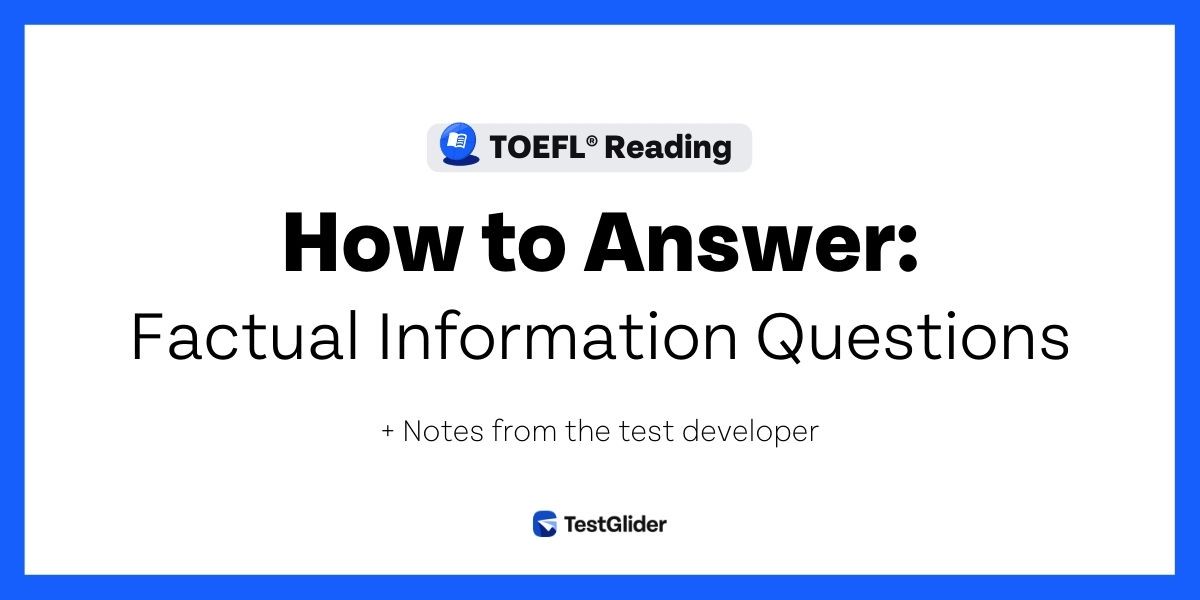Let’s learn how the TOEFL Reading factual information questions are made and how to choose the correct answer every time.
This post is part of a “How to Answer” series brought to you by our TOEFL test developer [TG_John] from the TestGlider team.
1. Information about Factual Information Questions
TOEFL Reading factual information questions ask the test takers to recognize information that was directly stated in a small part of the passage. They do not ask about general themes or ideas, rather they focus on information that appears only once in the passage. They may deal with major ideas, supporting details, or definitions and they generally focus on who, what, when, where, or why regarding actual events, individuals, etc.
Such questions may be written in many ways, but the following are some of the most common formats used by test developers:
- According to paragraph 1, which of the following is true of/about X ?
- The author’s description of X mentions which of the following?
- According to paragraph 1, who/what/where/why/how did X do Y?
- They may also be incomplete sentences that answer choices can complete:
- According to paragraph 1, X did Y because …
2. Question Example
Here is an excerpt from a passage and its Factual Information question:
“Scientists continued to gather information about black holes, but they could not confirm their existence until Cygnus X-1 was discovered in 1964. Astronomers were using radio telescopes to observe the constellation Cygnus (the Swan) when they detected high-energy x-rays and gamma rays. This radiation was being emitted as a black hole consumed gas from a blue supergiant star that was closely orbiting. As the gas spiraled down into the black hole, it formed a super hot accretion disk around it that was releasing bursts of electromagnetic radiation. Since then, many more black holes have been detected in various ways. Since a black hole’s gravity will pull on nearby objects, scientists can look for stars that make erratic movements when they pass by a black hole. Stars can also orbit black holes, so when a star appears to be orbiting nothing, it may be orbiting one.”
- According to paragraph 4, which of the following is true about Cygnus X-1?
(A) It is a blue supergiant star that orbits a black hole.
(B) It is located in a galaxy that is shaped like a swan.
(C) It was the first confirmed black hole to be detected.
(D) It emits high-energy x-rays and gamma-rays.
Explanation
The correct answer is (C). It is stated directly in the text.
(A) is incorrect. Cygnus X-1 is a black hole with a blue giant star closely orbiting.
(B) is incorrect. The blackhole is located in a constellation shaped like a swan, not a galaxy.
(D) is incorrect. The accretion disk around the blackhole is releasing bursts of radiation.
Notes from the Test Developer
Factual Information questions are the most common type of questions in TOEFL Reading passages, which usually include 2 to 4 of this question type.
There is a lot of variety in how the questions and answers are written. Distractors can work in many ways, but there are certain types that I prefer to use. Answers that are clearly false statements based upon the information presented in the passage are common, so I always use them.
There are also wrong answers that state factually correct information that is not mentioned in the passage. Others state unmentioned information that sounds like it could be accurate but is not. Some make statements that can be inferred from the information presented in the passage but not directly stated, which makes them incorrect for this type of question.
Advice to Test Takers
I would advise test takers to do a few things when they need to solve a factual information question. First, keep in mind that the correct answer must contain accurate information that is presented in the passage. However, that information may be partly or entirely paraphrased in the answer. Second, wrong answers may contain correct details from the passage, but they make false assertions about that information.
Sometimes that is as simple as making a negative statement about that information. Other times it may be more subtle, such as over or understating an amount or degree mentioned in the passage. For example, the passage may say that “some people” did something but the answer choice says that “all people” did that thing.
Details may also be mixed up on purpose, so that all of the details are present in the passage, but they are incorrectly stated in the answer choice. For all these reasons, you should carefully compare each answer choice to passage before you select the correct answer choice.
Finally, you have limited time, and the distractors are intended to confuse you, so you may be unable to decide between two answer choices. In that case, guess. Remember that you do not get points deducted for wrong answers in TOEFL. This is true for all questions so if you don’t know the answer or if you don’t have time to actually solve the question, guess.
